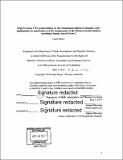High precision U/Pb geochronology on the Cenomanian Dakota Formation, Utah : implications for paleobotany and the transgression of the Western Interior Seaway preceding Oceanic Anoxic Event 2
Author(s)
Meyer, Laura (Laura B.)
DownloadFull printable version (5.760Mb)
Alternative title
High precision Uranium/Lead geochronology on the Cenomanian Dakota Formation, Utah : implications for paleobotany and the transgression of the Western Interior Seaway preceding Oceanic Anoxic Event 2
Implications for paleobotany and the transgression of the Western Interior Seaway preceding Oceanic Anoxic Event 2
Other Contributors
Massachusetts Institute of Technology. Department of Earth, Atmospheric, and Planetary Sciences.
Advisor
Samuel Bowring.
Terms of use
Metadata
Show full item recordAbstract
The Dakota Formation was deposited during the Cenomanian, a time when the Western Interior Seaway spanned much of North America. The Dakota Formation contains a rich record of plant and animal fossils. Key to understanding their importance, it is imperative to precisely place the Dakota Formation within the geological time scale. Volcanic ash samples interlayed with fossil bearing sandstones of the Dakota were collected from two localities in Westwater, and Henrieville, Utah. Samples were dated using isotope dilution thermal ionization mass spectrometry (ID-TIMS). The samples collected from the Westwater, Utah localities have a weighted mean 206Pb/238U date of 97.656±0.082 Ma, while the samples taken from Henrieville, Utah have weighted mean 206Pb/238U dates of 95.170 0.056 Ma and 94.941±0.032 Ma. Based on an analysis of stratigraphic, paleontological, and geochronological data, the Dakota Formation was then correlated across much of the Western Interior. These dates provide a base of the initiation of the transgression across Utah, and set a context for the CT boundary and OAE2 that follow.
Description
Thesis: S.B., Massachusetts Institute of Technology, Department of Earth, Atmospheric, and Planetary Sciences, 2010. Cataloged from PDF version of thesis. Includes bibliographical references (pages 31-35).
Date issued
2010Department
Massachusetts Institute of Technology. Department of Earth, Atmospheric, and Planetary SciencesPublisher
Massachusetts Institute of Technology
Keywords
Earth, Atmospheric, and Planetary Sciences.